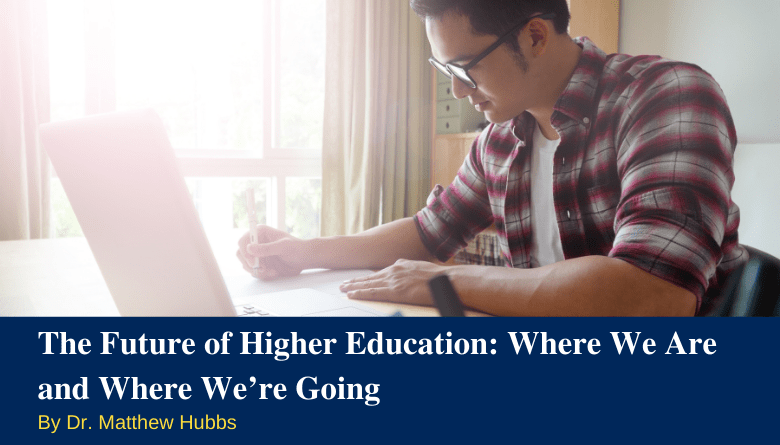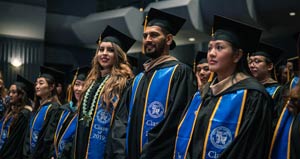
The Future of Higher Education: Where We Are and Where We’re Going
By: Matthew Hubbs, Ed.D., Dean of Academic Operations at Westcliff University (www.westcliff.edu)
Undoubtedly, 2020 has proven to be a noteworthy year of great change and adaptation to the collective “new normal” we now find ourselves living in. With the global COVID-19 pandemic forcing a shift across industries to remote life, management, work, schooling, and so much more, higher education is likewise far from immune to this flux. This sudden push for more technological solutions and capacities where distanced learning is concerned is unexpected, especially in comparison to the demand for such options even just a year ago, though not entirely unanticipated.
Currently, amid the age of learning highlighted by digital literacy, the trend of students’ growing comfortability with all things related to technology is nothing new to those in the know. Elementary students growing up with computers, tablets, and the internet have now emerged as college students that are effectively prepared for this modern digital landscape – and they are now consumers who have come to require that same flexibility and convenience within the university setting. This demand for high-tech learning options was always present and, in this light, the pandemic was more of an accelerant to what was already long inevitable.
With countless other learning institutions recently finding themselves playing catch-up to the immense challenges presented by online education needs over the last year, Westcliff University has already successfully implemented this tech-focused model for over a decade. A private university offering established live online learning experiences for all students, from those seeking their first bachelors degree to those pursuing a doctoral program, Westcliff possesses the unique track record, commitment to students’ needs, and experience to seamlessly transition into this new norm.
As such, here is a list of five predictions for the future of higher education, student experience, and technology solutions in 2021:
- Students have never before had so much power over their own educational experience. With the COVID-19 pandemic acting as a major contributor in this development, students now have a great deal of collective control over what happens next in the field of higher education. As distanced, remote, and online learning now become far more accepted – from elementary to college-level instruction – the in-person teaching models long held as the industry standard may soon become less and less common. With so many choices for tomorrow’s learners, the institutions that will thrive in the future will be those who truly and authentically put the needs of their students at the forefront of all their decisions.
- Education will play a significant role in reducing political and social division. In a world that finds itself increasingly divided – politically, socially, economically, and beyond – the question of what the true nature of education is and the consequences that stem from a lack of investment in it will become even more relevant. With the ever-common backdrop of fake news, both students and society as a whole are richly connected to the issue of trust in information. A level of introspection on the part of learning institutions, learners, and the leaders of nation and industry will be required to address these philosophical concerns and navigate a path forward into a future with greater common ground and mutual understanding.
- Institutions must be agile in adapting to the new definition of a university. Fundamentally, learning institutions will have to continue on the path brought forth by the global pandemic – challenging set norms and remaining flexible to changes that will continue to evolve. Anyone firmly clinging to the idea of universities returning to “the way things were” will soon find themselves behind the curve, as the old version of normal is unlikely to ever return. The old guard, people who have practices that were developed before modern technologies or employ learning models that no longer meet the developing needs of modern learners (if they ever fully did), may hinder the successful progress of a university in both 2021 and beyond in the post-pandemic future. To remain relevant and beneficial to the needs of their students, universities must commit to solutions-focused strategies in response to an ever-changing world.
- Short-term credentials will dominate the higher education landscape. In the modern world, employers are primed to place a greater emphasis on the value of skills over degrees. This is likely to become more commonplace in the wake of COVID-19. In the new normal of our post-pandemic future, college students will come to see the benefit in stackable certificates – a documentation of developing skillsets while pursuing undergraduate or graduate degrees. With growing unemployment and lost jobs over the last year, the value of certifications is evident and even instrumental in finding new work as primary income earners do not have a 2-4 year window to earn a degree before they rejoin the workforce. For traditional college-age students, education and experience need no longer be mutually exclusive in their timelines. Innovative universities will provide students the opportunity to earn credentials as they are working toward their degrees. With flexible class schedules, students can gain marketable skills and credentials to start or resume their careers while still pursuing their degrees. Solutions such as these will undeniably bridge the gap between college degrees and marketable skillsets for college students in the future.
- How universities support the health and well-being of students must dramatically evolve. With the surge of remote online learning, students are connected virtually all the time, and this constant connection creates a new and different set of challenges that can interfere with the learning process as well as other aspects of life. This adds a never before experienced level of complexity, especially when considering how students disconnect and find time to tend to themselves. There is immense overlap between the virtual classroom or workplace, via a computer, and recreation. When all our boundaries are mixed together – a table where we work, eat dinner, teach our kids, etc. –this separation becomes even more difficult. These are truly new waters that will require navigation in the months and years ahead. Universities must find creative and effective ways to support their students’ health and well-being as their individual worlds continue to see more spillover into one another.
With the need for flexibility on the part of universities and the modern education solutions for learners, the college experience may look very different for students in the future, especially for those fresh out of high school. In the short term, many institutions will live and die by their commitment to students’ needs – and there is still clearly a hunger for that old sense of normalcy. However, tomorrow’s generation of post-secondary learners have been exposed to new possibilities, and while not every aspect of those new possibilities may have met their educational needs, they are equipped with a more diverse set of skills related to learning that universities should be prepared to accommodate.
Whereas experienced college students may seek the familiar – backpacks, in-person lectures, and walking down the halls of campus – when it comes to incoming freshmen, more students will be familiar with the structure of remote and distance learning. Online instruction via platforms such as Zoom will be all the more common and where there may have been leniency for the initial learning curve institutions required to initially learn these technologies, incoming college students in the future will arrive having the expectation that the university has the structures in place and figured out. If these institutions do not, then it is doubtful these students will stick around; true digital natives don’t have time for people who can’t embrace the technology required to meet their needs or who lack digital savvy.
In truth, there remain many unknowns regarding the future of higher education, especially as they relate to the changes forced upon learning institutions by COVID-19. University leadership can only predict what to expect in regard to the pandemic and what it’s permanent impact on educational models will be in the years to come. Students at all educational levels were forced into the role of becoming remote learners in 2020, and it is the job of educational institutions in 2021 and beyond to respond accordingly – with the flexibility in our approach to student needs now emerging as more important than ever before.
About the Author: Matthew Hubbs, Ed.D., serves as dean of academic operations at Westcliff University. Westcliff University (WU), founded in 1993 is a private university in Irvine, Calif. offering bachelor’s, master’s and doctorate degrees spanning 21 areas of study, including business, education, STEM – and most recently law – after its 2019 acquisition of Western State College of Law.






